An enlightening chat with my local plant supplier taught me yet another discouraging fact about seedlings sold by large commercial nurseries. Many are treated with neonicotinoids to kill insects, hormones to retard plant growth and yet more poisons to prevent disease. Then, the plants are doused in chemical fertilizers to keep them unnaturally green until sold.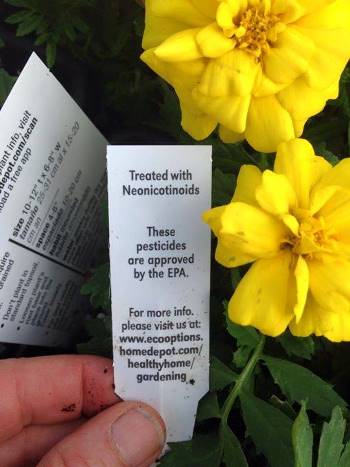
Unfortunately, there is usually no way of knowing what toxins may have been used on those plants.
“Most big growers spray their plants to keep them small and compact so they look nice in a pack,” Margie Lennington, owner of Lazy Ox Farm of Alton, Mo., told me when I stopped to learn more about the plants she sells. “Big growers aren’t thinking about your harvest or how that plant will grow for you when you get it home.”
Margie and husband Ron, along with 10-year-old daughter Sarah and 20-year-old college student son Andy, run a completely organic homestead farm with a large greenhouse, gardens and livestock. Their goal is to be totally self-sufficient with food, including for their animals.
In a snap, Margie listed four solid reasons we should all buy local, organic seedlings: The plants are adapted to the environment, the nursery does not use hazardous chemicals, buyers can have a conversation with the people who grew the plants, and we’re supporting small growers.
Especially horrifying in big-ag is the now common practice of treating seedlings or soil with neonicotinoids. The plants take the chemical up systemically through their roots, deterring pests. Neonicotinoids can’t be washed off – and they kill bees.
“It should be illegal,” Margie said.
Mother Earth News has been warning us for years about the dangers of neonicotinoids. Many European countries have already banned them. To learn more, see “Buy Organic: Reject Neonicotinoid Insecticides” and “The Dangers of Neonicotinoid Pesticides,” just two of the excellent Mother Earth articles on this topic.
A June 2 Facebook post by consumer advocate Erin Brockovich also urges Americans to take action against the use of bee-killing chemicals. “Do not, I repeat, do not buy plants treated with neonicotinoids,” Brockovich writes. “Bees take the pollen back to the hive and feed it to the brood. This is the number one cause of colony collapse!”
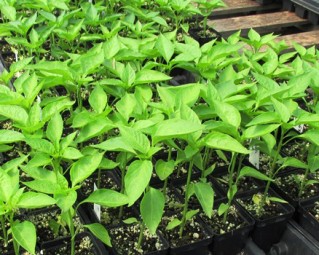 Large nurseries, and some small ones, fertilize their plants with a foliar fertilizer to make them big and lush and green, which appeals to gardeners. But, when consumers plant those abnormally verdant, extraordinarily green seedlings in their gardens, the plant must first overcome the chemicals. Meanwhile, they will likely turn yellow, wilt, and be slow to take off, Margie told me. If the leaves (a plant’s energy source) die, growth will be stunted.
Large nurseries, and some small ones, fertilize their plants with a foliar fertilizer to make them big and lush and green, which appeals to gardeners. But, when consumers plant those abnormally verdant, extraordinarily green seedlings in their gardens, the plant must first overcome the chemicals. Meanwhile, they will likely turn yellow, wilt, and be slow to take off, Margie told me. If the leaves (a plant’s energy source) die, growth will be stunted.
The foliage may be beautiful, but the roots, where it is most vital, are not developed enough to support all that artificial growth.
“Roots are more important than the top at this stage,” Margie said, gently lifting an Ozark Giant pepper plant from its 4-inch pot to show me the roots. The healthy-looking white roots were spread throughout the soil, not wound into a ball or trailing through the pot’s drain holes.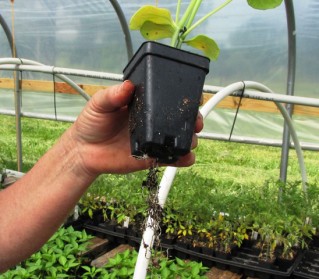
“When a plant is properly fertilized through its roots, its growth will be balanced and the roots will be trained to take up nutrients,” Margie said. “It will take off and grow faster and be hardier .”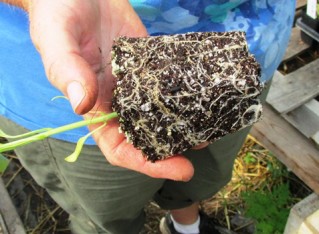
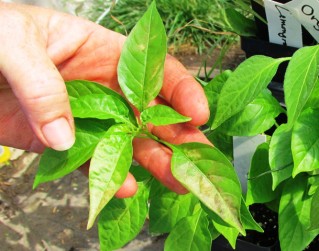 Because she doesn’t use chemicals on her land, Margie never has to. Her greenhouse and garden plants resist pests and diseases on their own, after countless generations of developing immunity to sickness. Excessive nitrogen in foliage actually leads to pest and disease problems. Those lush, overfed leaves attract aphids, other harmful insects and diseases. Margie has so few pests and diseases simply with healthy soil and proper, balanced fertilizing. She also never uses non-organic fertilizers or hormones. Her rodent control is a cat and beagle.
Because she doesn’t use chemicals on her land, Margie never has to. Her greenhouse and garden plants resist pests and diseases on their own, after countless generations of developing immunity to sickness. Excessive nitrogen in foliage actually leads to pest and disease problems. Those lush, overfed leaves attract aphids, other harmful insects and diseases. Margie has so few pests and diseases simply with healthy soil and proper, balanced fertilizing. She also never uses non-organic fertilizers or hormones. Her rodent control is a cat and beagle.
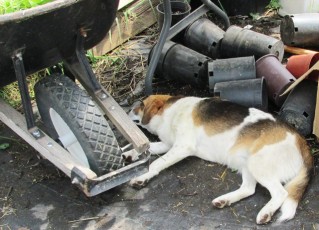 I am embarrassed to admit, for the first time in a long, long time, I bought a four-pack of crooked neck squash seedlings from one of those mega-home centers. My lame excuse is I was in a hurry to get home and trying to use up a $50 gift certificate. But now I face a terrible dilemma. And Margie was right – the plants took weeks to come to life.
I am embarrassed to admit, for the first time in a long, long time, I bought a four-pack of crooked neck squash seedlings from one of those mega-home centers. My lame excuse is I was in a hurry to get home and trying to use up a $50 gift certificate. But now I face a terrible dilemma. And Margie was right – the plants took weeks to come to life.
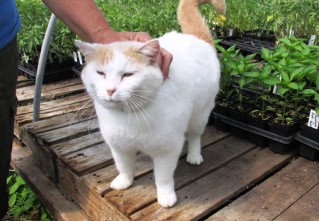 Now that the plants are green and blossoming, I don’t know what to do with them. I don’t want to eat the squash; I don’t want the plants in my soil or compost pile; and I don’t want to feed them to the goats. This situation is especially distressing to someone like me who truly loves plants. To intentionally kill one is herbicide.
Now that the plants are green and blossoming, I don’t know what to do with them. I don’t want to eat the squash; I don’t want the plants in my soil or compost pile; and I don’t want to feed them to the goats. This situation is especially distressing to someone like me who truly loves plants. To intentionally kill one is herbicide.
I vow to never make that mistake again.
Consumers also do not know where most of those seeds were grown. Seed catalogs do not contain that information; nor do seed packets or seedling containers.
“An heirloom plant grown from locally produced seed is adapted to the environment,” Margie told me, “whereas one grown from seed produced in Japan or Washington might not grow well here.”
Consumers also do not know now who owns the seed company that produced the seed. In the last 20 years, there has been a consolidating in the seed industry in the last 20 years with a few mega corporations buying up smaller seed producers. Monsanto is, of course, one of the biggest buyers of smaller seed companies. To learn more, see this 2015 article, “Where to Buy Non-GMO Seeds,” by Mother Earth News editor Cheryl Long.
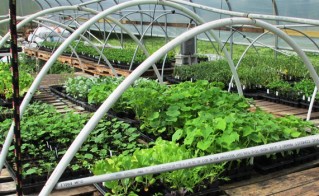 Margie learned decades ago that properly grown heirloom and organic plants are more disease- and pest-resistant, hardier and better producers than their hybrid cousins laden with chemicals. Plus, the seeds of heirloom plants can be harvested year after year into perpetuity. They are inherently better for the environment.
Margie learned decades ago that properly grown heirloom and organic plants are more disease- and pest-resistant, hardier and better producers than their hybrid cousins laden with chemicals. Plus, the seeds of heirloom plants can be harvested year after year into perpetuity. They are inherently better for the environment.
When Margie, who was then living in Idaho, went land-shopping several years ago in the Midwest, she did so with a baby on her hip and a shovel in her hand. Selecting a home for her family had nothing to do with curb appeal or the size of bedrooms. It had everything to do with dirt.
A gardener all her life, and for the past 18 years earning a living from her garden, Margie needed land with good soil for growing vegetables. Poor soil can be built up, but generally takes years of adding organic amendments and hauling off rocks.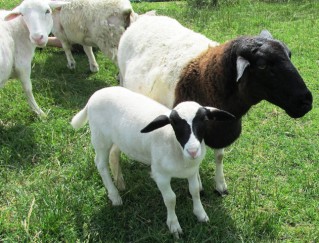
Margie’s scrutiny with a spade paid off when she found her dream property in the Missouri Ozarks, an area notorious for a plethora of rocks and not so much topsoil. Surprisingly, her three gardens are virtually rock-free. A soil test, however, revealed a lack of magnesium, a must for tomatoes.
Margie’s octogenarian neighbor gave her a recipe for terrific tomato yields – an equal mixture of Epsom salt, lime and sugar. Just 2 tablespoons in each tomato hole and another sprinkling at blossom time provides the extra nutrients tomatoes need. This information was unavailable from big nurseries, but free through a friendly conversation, the same kind of one-on-one available from small producers like Lazy Ox Farm.
With a cup of coffee, Margie spends her mornings returning email and phone messages from customers, who often “pick her brain” about new plant varieties, ideal growing conditions and other such horticultural queries.
Because it is so much fun and she wants to find the absolute best heirloom plants to offer, Margie tries dozens of new types each year. She keeps detailed records of their progress. Of the 10 or so different tomato plants she trials annually, she will reject about half.
“Every variety I sell, I grow myself, so I know it grows well,” Margie said. “There are plenty I trial that I wouldn’t sell.”
One of Margie’s favorite tomatoes, “Joe’s Pink,” started with seeds from her mailman, who got them from the postmaster, who got from a man whose parents brought the seed from Italy decades ago. Joe’s Pink is a huge oxheart that is great for pastes and sandwiches.
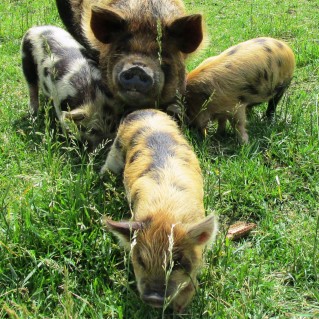 Besides growing gardens and fruit trees, Margie and her family raise heritage pigs, sheep, a dairy cow, turkeys and chickens on their homestead. They are well on their way to self-sufficiency, already raising and storing a great deal of food and livestock feed they’ve grown themselves.
Besides growing gardens and fruit trees, Margie and her family raise heritage pigs, sheep, a dairy cow, turkeys and chickens on their homestead. They are well on their way to self-sufficiency, already raising and storing a great deal of food and livestock feed they’ve grown themselves.
I learned so much from my greenhouse tour that I was reluctant to leave. When Margie sent me home with a tray of plants that needed to be put into the ground that day, she said, “I’ve created so much work for you.”
It’s not work, I said. Margie smiled knowingly.
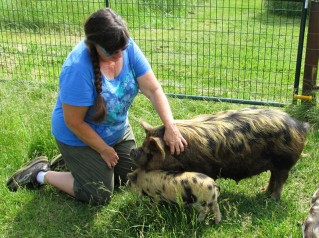 We are thankful for small growers like Lazy Ox Farm who work hard to keep heirloom plants in our future. You will never find a hybrid plant on her farm, but you will find rare varieties unattainable anywhere else. Her plants are available online, carefully packaged and shipped to customers’ doors with detailed growing instructions, and in local shops, such as the Oregon County Food Producers and Artisans Cooperative.
We are thankful for small growers like Lazy Ox Farm who work hard to keep heirloom plants in our future. You will never find a hybrid plant on her farm, but you will find rare varieties unattainable anywhere else. Her plants are available online, carefully packaged and shipped to customers’ doors with detailed growing instructions, and in local shops, such as the Oregon County Food Producers and Artisans Cooperative.